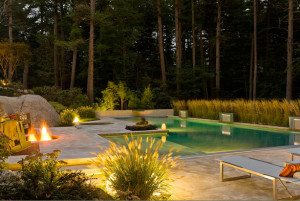What’s a Memory Worth?
August 30, 2010
Text by Louis Postel
The heady mix of summer rain and sea air on a Providence street. A trellis of concord grapes behind a suburban Boston Victorian. A battered trunk in an island cottage off Portland, Maine. Certain things can trigger memories so powerful they bring water to the eyes of grown men. These are the scents, sounds and spaces that transport us to childhood like the freshly baked madeleines in Proust’s Remembrances of Things Past.
What will happen to these memory triggers in this new post-recessionary economy? Now that we’ve been duly chastened for our faith in upward-spiraling real estate values, will all these whimsies fall by the wayside? Hard-nosed types will argue, “Do you really need that turret overlooking the water? And while we’re on the subject, do you really need a special bay window to accommodate that old trunk?”
Much has changed forever. Priorities need to be set and budgets met. As history has shown, designers and architects have acted as the first line of defense in this regard. Even in the most prosperous times they have proven to be critical partners in setting priorities and hierarchies, presenting options and trade-offs. Right now, the design community is redoubling its efforts to add value. Still, we forecast the reemergence of the design equivalent of Proust’s madeleines—triggers that satisfy the emotions—without necessarily requiring an application for a second mortgage.
The French-Italian designer Nathalie Ducrest, now of Chestnut Hill, Massachusetts. Ducrest has retained the Paris-born perfumer Marc Henri, who now lives in Lexington, Massachusetts, to compose a custom home scent for a client. “In France a woman feels totally undressed without perfume. In general, women and men wear a lot more perfume than here in the States. It leaves a trace throughout their homes,” Ducrest says. A Glade Plug-In won’t quite suit the kind of luxurious home Ducrest is becoming known for. Henri will start the custom design process with a questionnaire before reaching for his blue bottles of bergamot, sandalwood and lavender. What scents from childhood do you remember? Summer rain on Providence pavement’s got to be a big seller.
Childhood wouldn’t be complete without lying on the rug some summer afternoon watching the rosettes in a chandelier catch fire as the sun makes its way west. “But the chandelier’s really got to fit the space,” says designer William Hodgins. “When it’s too small it really doesn’t work.” Hodgins and his assistant, Penny Matteson, were heading to New York to find just the right one for a client. “Our favorite is an original from H.M. Luther, but it may just be too small—and for $150,000 it’s got to be right.”
Few architects are as agile at balancing dreams and dollars as John DaSilva of Polhemus Savery DaSilva in Chatham on the Cape. A project in Chatham’s historic district was on hold for ten years, “but finally the family just found their original house bursting at the seams,” he says. “Our first schematic for the new house showed only a terrace with no porch to help conform to the budget. They lived with those drawings for a while, but in the end came to the conclusion that outdoor living and a covered porch was really, really important. And, of course, something like that is significantly more money, but well worth it.” Doubtless, freshly baked madeleines will find their way to this porch a summer or two from now.
Designers at the rosy dawn of their careers wisely seek out mentors such as Jody Trail of Sudbury, Massachusetts. But only so many make the grade. “I knew Sarah McGuire was the real thing when we were doing a shoot for a house on the Cape,” Trail says. “Sarah just chased the people off the beach so we could do the house. ‘Shoo, shoo, shoo’ she said, and it worked!” Boston-based McGuire and Trail and have since teamed up on Decor Kit, an online program that lets budget-minded clients get help decorating their houses. Fill out a questionnaire, send in pictures of the room you want to re-do, and Trail and McGuire send you a design plan. “Now that Domino magazine is gone, young people are desperate. They know their spaces aren’t coming together and feel stuck,” says Trail.
The intoxicating fragrance of summer rain on city pavement is hardly exclusive to Providence. And it’s drawing empty-nesters in droves to high-end projects such as Boston’s Intercontinental, the Mandarin and Four Seasons, as well as to townhouses in the South End, Back Bay and Beacon Hill. To describe the ins and outs, designer Leslie Fine of Boston teamed up with architect Douglas Dick of LDa Architects in Cambridge and builder Allison Perry Iantosca of FH Perry in Hopkinton, Massachusetts, on a panel at this year’s BSA Residential Show. Dick summed up working in these tight urban spaces as a “mad shuffle.” Just try moving a sprinkler situated in the center of a foyer awaiting the arrival of one those chandeliers with the cobalt rosettes. Get plans approved. Shut off all water on floor. Alert neighbors. Get inspectors over same day as installation.
Wallpaper is making a comeback, triggering many a childhood memory: for one homeowner it was how the peacock and pagoda patterns were lit by passing cars as she fell asleep, almost like a dream. “Bold wallpapers on the ceiling are hot,” says designer Susan Shulman of West Newton, Massachusetts. Designer Penny Daborn of Portland, Maine, agrees about the wallpaper comeback, noting the post-recessionary exuberance of citrus green and peacock blue on her latest color boards.
Don’t all oak floors look the same? There are only a certain number of finishes. If there’s a childhood memory attached it’s usually about splinters or spilt milk. But not anymore, according to Medfield architect David Sharff, who is in the midst of fusing two chopped-up Back Bay condos into a streamlined big one for a growing family. “The floors are a new product from Italy we found at Paris Ceramics in the Boston Design Center, manufactured by Itlas,” he says. “It’s a thickly veneered oak over plywood, a completely engineered product, so we knew what our particular finish was going to look like just from the sample.” Sharff is part of a team that includes interior designer Amy McFadden and one of Back Bay’s preferred builders, Rick Cantelli of C-Concept.
Surely, for some toddler a madeleine will prove mighty tasty eaten right off those imported boards. Hard-headed, dollars and cents advisers may wince and harrumph while unfurling their spreadsheets. But, fortunately, homeowners have equally sagacious voices in their corner. If anything, their architects and designers have become even more skilled at resolving the perplexities of future investment value with the fondest remembrances of things past.
Share
![NEH-Logo_Black[1] NEH-Logo_Black[1]](https://www.nehomemag.com/wp-content/uploads/2022/08/NEH-Logo_Black1-300x162.jpg)







